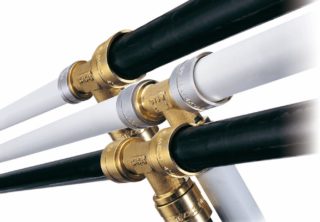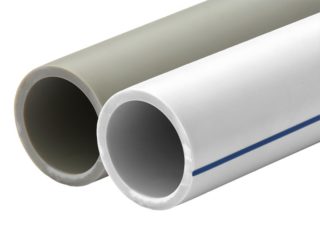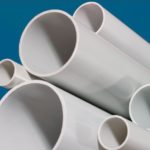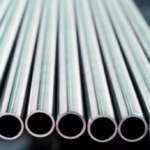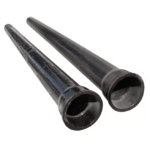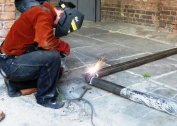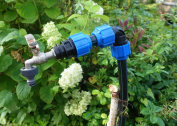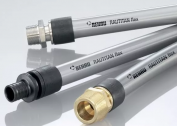The assortment of pipes on the market for plumbing and sewage is very wide. Products are made of different materials, have a different internal section (conditional passage). Each diameter is designed for specific operating conditions. It is important not to make a mistake when choosing steel, cast iron, plastic water pipes with a diameter of 50 mm or more / less. Installation of the system taking into account its nominal operating pressure is the key to the reliability of the finished water supply or sewage line.
Purpose of water pipes with a diameter of 50 mm
As a rule, tubes of the named section are used in such cases:
- Laying the inside of the sewer: drainage from the sink, bathtub, shower, bidet.
- Installation of the outer part of the water supply, provided it is of considerable length and water is supplied to apartment buildings.
- Cable network device.
- Oil production (steel pipes).
- Installation of a heating system in the house.
- Gas transportation to residential buildings (steel, cast iron).
Also, tubes with a cross section of 50 mm are used in the field of energy and engineering.
Specifications
Pipes with a diameter of 50 mm have different technical characteristics depending on the material from which they are made. But there are similar parameters:
- The working pressure in the system for tubes of 50 mm is from 7-10 bar.
- The length of pipes sold (polymers) is from 25 cm to 1.5 m. Steel is from 5 meters.
- Polymeric products are dielectrics - they do not conduct electricity at all or in minimal quantities.
- The density of the polymer is 0.95-1.4 g / cm3.
- Service life of 50 years for plastic. From 30 years - for steel and cast iron.
- The maximum temperature of the pumped fluids for polymers is +90 degrees. Metals - +110. It is optimal to transport water with an indicator not higher than +65 degrees. Otherwise, the pipes fail faster.
In terms of strength of the PVC tube, HDPE is seriously inferior to steel products. But with their proper operation / installation, plastic can withstand severe loads in the form of soil pressure (when laying the outer parts of the water supply).
Production material
There are several varieties of tubes with a cross section of 50 mm on the market:
- Steel pipes. The metal is durable and, until recently, was in good demand. However, private craftsmen abandoned steel due to the complexity of the installation process. The metal tends to be covered with condensate on the outside, and on the inside it is overgrown with limescale (during transportation of hot water). Steel is prone to corrosion. An additional minus of steel pipes is high electrical conductivity.
- Cast iron products. Until recently (the end of the 20th century), only such tubes were used in private construction. Now they also give way to lighter, no less durable materials. Although cast iron has been used for over 50 years, its tendency to siltation and corrosion plays a negative role. In addition, the installation of metal pipes requires welding or the installation of threaded joints, and this is an additional labor cost.
- Polypropylene pipes with a diameter of 50 mm for cold water (if they are used for laying an external water supply). This material is the most popular. It has good ductility, prone to linear stretching. Due to the perfectly smooth inner walls it transports large volumes of water or effluent without any problems. At the same time, the system is not silted up.
- PVC pipes. The most common version of products for the device of the internal part of the sewage system. Capable of pumping both cold and hot water / drains.Resistant to mechanical damage, lightweight, extremely easy to install.
- HDPE (low pressure polyethylene) products. They behave well even when the water in the system freezes. If you take tubes of cross-linked polyethylene, you can equally efficiently transport both cold and hot water through them.
- PVC
- Steel
- Cast iron
- PND
Choosing pipes without preliminary engineering calculations is not recommended. At a minimum, it is advisable for a private master to look into SNiP.
Criterias of choice
When buying pipes with a cross section of 50 mm, it is important to be guided by such indicators:
- Appointment of products. For private construction or laying of internal communications of short length it is better to take PVC pipes. If we are talking about a more global installation of highways, use steel or HDPE products.
- The working pressure of each material. Standard centralized water supply operates at rates from 3 to 7 bar (4 bar is considered the norm). But the peak performance can sometimes reach 10 bar (the first test is always carried out at a pressure of 12 bar). Pipes need a margin of safety.
- Convenience of installation. The simplest are PVC tubes. If we are talking about metal, the process of communication device is many times more complicated.
If you take pipes under the screed, it is better to give preference to polypropylene products.
Mounting Features
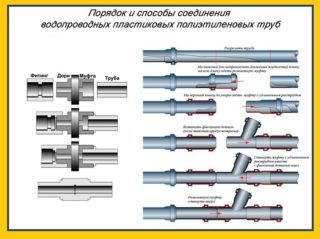 Installation of tubes with a diameter of 50 cm is carried out depending on the material from which they are made:
Installation of tubes with a diameter of 50 cm is carried out depending on the material from which they are made:
- PVC join the socket with the help of special rubber sealing cuffs. The gasket is pre-treated with silicone sealant for greater reliability. Then they drive the next section of the tube into the socket until it stops. It is important to arrange the elements so that the bell looks in the direction of movement of water or effluents. If a sewer system is installed, do not forget to make it slope towards the common riser at the rate of 1 cm per meter of the line.
- Polypropylene pipes are soldered using special equipment with nozzles and the same PP fittings. For joining, the soldering iron with nozzles is heated to a certain temperature, put the end of the pipe on it until the material softens. Then the tube is driven into the fitting until it stops. The cooling polypropylene forms a tight connection with a clamp of the same material.
- The polyethylene tubes are joined using electrofusion fittings. The sleeve is put on at the junction of the two pipes. A special spiral built into the cuff heats it until it melts easily. The result is a strong, tight connection.
- Steel pipes are subjected to mandatory welding during installation. Pig-iron products are either boiled or joined into the socket by the method of caulking.
When arranging any highway, sharp turns, straight or sharp corners should be avoided. Correct any bends using rotary fittings. On the sewer line, it is desirable to install the revision hatch in an accessible place for inspection. This is especially important if the pipes are laid under a decorative finish or screed.
The price of pipes per meter and piece
Prices per meter of HDPE pipe with a diameter of 50 mm or tubes of steel, cast iron, PVC vary depending on the region of sale, but slightly. Estimated cost of products:
- steel tube - from 306 rubles / meter;
- cast iron (length 2 meters) - 1,440 rubles / pcs .;
- PVC - from 24 rubles / pcs. depends on the length of the product;
- PND - from 33.60 rubles / meter.
When buying pipes made of polymers, pay attention to the uniformity of their color. Whitish spots on the surface of the product indicate that the technology of its production has been violated. Over time, such a tube will not withstand operation.
